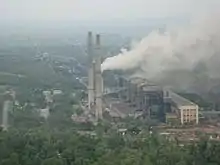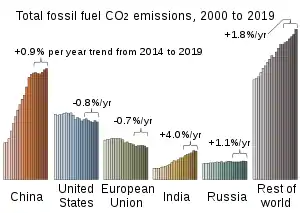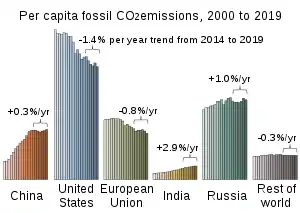Greenhouse gas emissions by India
Greenhouse gas emissions by India are the third largest in the world and the main source is coal.[1] India emits about 3 gigatonnes (Gt) CO2eq of greenhouse gases each year; about two and a half tons per person, which is half the world average.[2] The country emits 7% of global emissions.[3]

As of 2019 these figures are quite uncertain, but a comprehensive greenhouse gas inventory is within reach.[4] Cutting greenhouse gas emissions, and therefore air pollution in India, would have health benefits worth 4 to 5 times the cost, which would be the most cost-effective in the world.[5]
As of 2014, India's carbon intensity per GDP was twice the world average. The Paris Agreement commitments included a reduction of this intensity by 33-35% by 2030.[6]
Greenhouse gas sources

2 emissions in India are much less than China but rising much more quickly.[7]

India emitted 2,600 Mt of CO2eq in 2014 (2,300 Mt with LULUCF).[8]
Energy
Energy in India is the main source. As of 2019 fossil fuels were subsidized more than clean energy.[9]
Electricity generation
As of 2019 three-quarters of electricity is generated by burning fossil fuels.[10] Energy emissions increased by 1,563 megatons CO2eq from 1990 to 2014.[6] Over 74% of energy was generated by coal in 2014.[6]
Coal fired power stations
As well as coal mining in India, the country also imports coal[11] to burn in coal-fired power stations in India. New plants are unlikely to be built, old and dirty plants may be shut down and more coal may be burnt in the remaining plants.[12]
Transport fuel
90% of transport emissions are from road transport.[13]
Household fuel
Switching from traditional fuels to liquefied petroleum gas and electricity provides health and climate benefits.[14]
Industry
A quarter of emissions are industrial[15] mainly from producing cement,[16] iron and steel.[13] Industrial sector fuel consumption increased by 406% between 2000 and 2014.[6]
As of 2014, 42% of energy was also consumed by industry.[6]
Agriculture
Agricultural emissions increased 25% between 2005 and 2014, in part due to significant increases in the use of artificial fertilizers.[6]
Greenhouse gas sinks
Land use, land-use change, and forestry absorbed 300 Mt of CO2eq in 2014[13] and in 2020 total carbon stored in forests was 7000 Mt.[17]
Energy efficiency
India's Intended Nationally Determined Contribution includes reducing emission intensity by a third by 2030.[1]
Planning and forecasts
The UNEP forecasts that by 2030 India's annual emissions per person will be between 3 and 4 tonnes.[3]
Reporting
As a party to the Paris Agreement India is due to submit its first Biennial Transparency Report (BTR) to the UNFCCC by 2024 and inventory figures in standard format.[18]
Mitigation
Energy
The National Energy Plan is in accord with the Paris Agreement target of 2 °C global warming, but if India stopped building coal-fired power stations it would meet the 1.5 °C aspiration.[19] India pledged to achieve electric power generation of 40% percent non-fossil fuel energy by 2030.[6]
Economics
India’s economy is forecast to grow significantly, with gross domestic product rising 7-8% annually. The government expects electricity capacity needs to nearly double to 2027. With accelerated coal plant closures, and an anticipated surge in renewables, thermal power will account for only an estimated 42.7% of installed capacity across India by 2027, down dramatically from 66.8% in 2017.[20]
Co-benefits
Cutting greenhouse gas emissions, and therefore air pollution in India, would have health benefits worth 4 to 5 times the cost, which would be the most cost-effective in the world.[5]
Politics
The Indian Central Government as well as various state governments have taken certain steps in accordance with India's energy policy and the Paris Agreement. Following are some of those steps:
- Doubling India’s renewable energy target to 450 gigawatt (GW) by 2030 [21]
References
- "The Carbon Brief Profile: India". Carbon Brief. 2019-03-14. Retrieved 2019-09-25.
- "Greenhouse Gas Emissions in India" (PDF).
- Environment, U. N. (2019-11-19). "Emissions Gap Report 2019". UNEP - UN Environment Programme. Retrieved 2020-04-20.
- "A comprehensive GHG inventory for India is within reach". www.downtoearth.org.in. Retrieved 2019-09-25.
- Sampedro, Jon; Smith, Steven J.; Arto, Iñaki; González-Eguino, Mikel; Markandya, Anil; Mulvaney, Kathleen M.; Pizarro-Irizar, Cristina; Van Dingenen, Rita (2020-03-01). "Health co-benefits and mitigation costs as per the Paris Agreement under different technological pathways for energy supply". Environment International. 136: 105513. doi:10.1016/j.envint.2020.105513. ISSN 0160-4120. PMID 32006762.
- "Greenhouse Gas Emissions Factsheet: India". Climatelinks. Retrieved 2020-04-23.
- Friedlingstein et al. 2019, Table 7.
- 2nd biennial report (2018), p. 5.
- "Mapping India's Energy Subsidies 2020 - Global Subsidies Initiative IISD". Mapping India's Energy Subsidies 2020. Retrieved 2020-04-23.
- "Analysis: India's CO2 emissions growth poised to slow sharply in 2019". Carbon Brief. 2019-10-24. Retrieved 2020-04-20.
- "India, World's No. 2 Coal Buyer, Plans to Cut Imports by a Third". www.bloomberg.com. Retrieved 2019-09-27.
- "How Long Will Coal Remain King in India?". www.greentechmedia.com. Retrieved 2021-01-21.
- 2nd biennial report (2018), p. 8.
- Maji, Poushali; Kandlikar, Milind (2020-04-01). "Quantifying the air quality, climate and equity implications of India's household energy transition". Energy for Sustainable Development. 55: 37–47. doi:10.1016/j.esd.2019.11.006. ISSN 0973-0826.
- "India's Industrial Sector GHG Emissions". www.ghgplatform-india.org. Retrieved 2020-04-20.
- Balsara, Sachin; Jain, P. K.; Ramesh, Anbanandam (2020). Shunmugam, M. S.; Kanthababu, M. (eds.). "Analyzing Enablers of Emission Reduction Strategies of Cement-manufacturing Industry of India under Fuzzy Environment". Advances in Simulation, Product Design and Development. Lecture Notes on Multidisciplinary Industrial Engineering. Singapore: Springer: 571–581. doi:10.1007/978-981-32-9487-5_47. ISBN 978-981-329-487-5.
- "Carbon stock in forests: Kerala tops among south Indian states". Mathrubhumi. Retrieved 2020-04-23.
- "Reporting and Review under the Paris Agreement". unfccc.int. Retrieved 2020-04-20.
- "Climate change report card: These countries are reaching targets". Environment. 2019-09-19. Retrieved 2019-09-26.
- "IEEFA India: New National Electricity Plan Reinforces Intent Toward 275 Gigawatts of Renewables-Generated Electricity by 2027". Archived from the original on 2019-09-26.
- "Govt to ease land acquisition, finance for renewables to meet 450 GW target". Archived from the original on 2019-09-26.
UNFCCC
- "Second Biennial Update Report" (PDF). Ministry of Environment, Forest and Climate Change. December 2018.
- "Nationally Determined Contributions submitted to UN". www4.unfccc.int. Retrieved 2019-10-31.